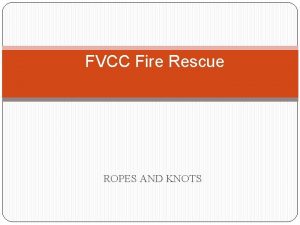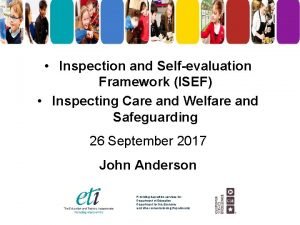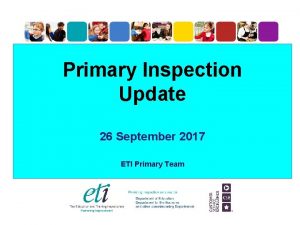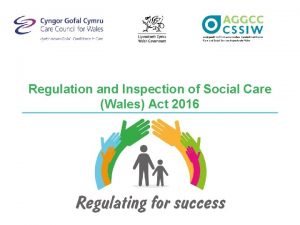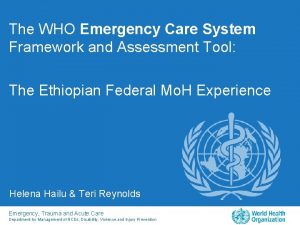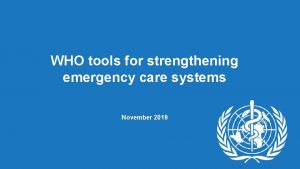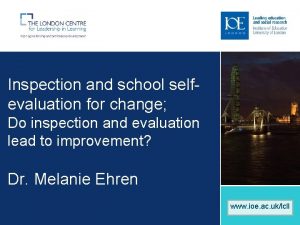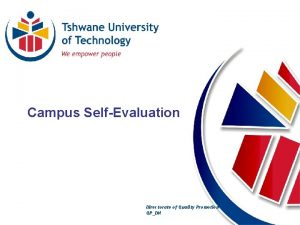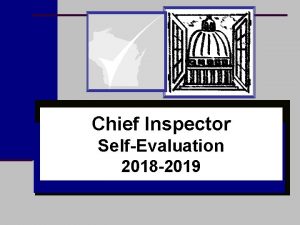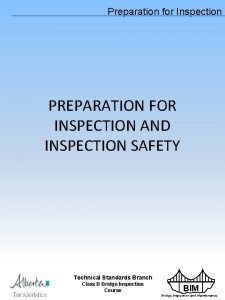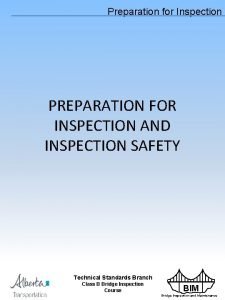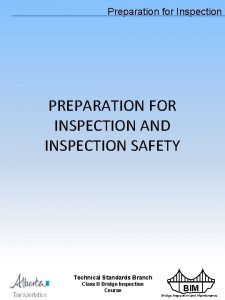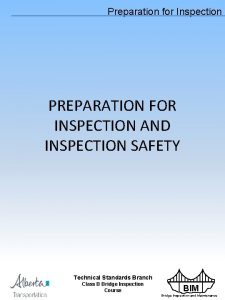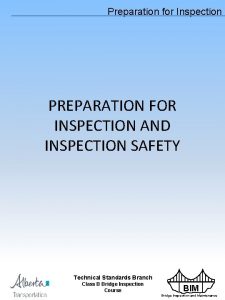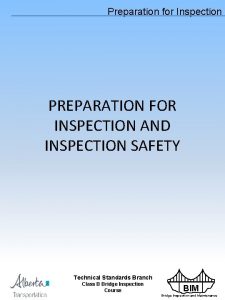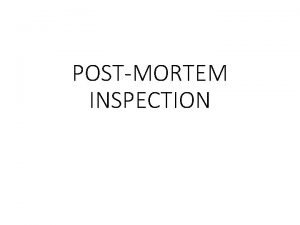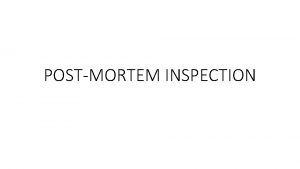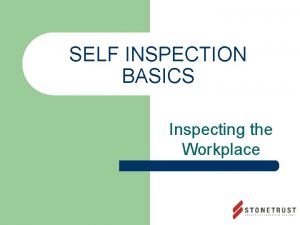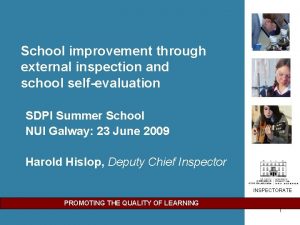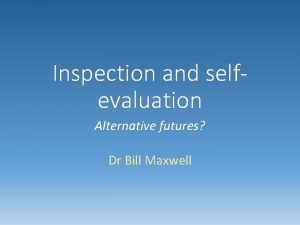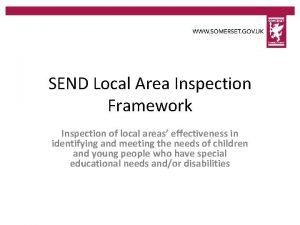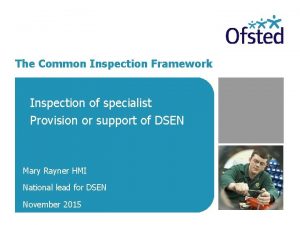Inspection and Selfevaluation Framework ISEF Inspecting Care and
























- Slides: 24

• Inspection and Self-evaluation Framework (ISEF) • Inspecting Care and Welfare and Safeguarding 26 September 2017 John Anderson Providing inspection services for: Department of Education Department for the Economy and other commissioning Departments

Revised (Jan 2017) Inspection and Self-Evaluation Framework (ISEF) • Key areas remain: – Leadership and management – Quality of provision for learning – Outcomes for learners • Slimmed down to strengths/AFIs for 9 essential quality indicators • Holistic evaluations of care, welfare, safeguarding and governance • Inclusion of characteristics of best practice and challenge questions to support self-evaluation • ETI does not ‘inspect’ for the use of ISEF – schools are free to adapt suitable indicators (can continue to use TTI etc. ) for their stage of development

ISEF • • • A more holistic overview Consistent across all phases and sectors Open and transparent Focuses on the key aspects, not all aspects Care, welfare and safeguarding are paramount Designed to enable self-reflection leading to improvement Not designed to be a check-list Helpful to focus on key transition points Useable at all stages of development of the organisation



Outcomes for learners • Standards attained – Knowledge, skills and understanding across areas of learning – High expectations – Thinking skills, personal capabilities • Progression – Consistent and commensurate with ability – High quality assessment and feedback • Wider skills and dispositions – – Self confidence and self-esteem Resilience and positive engagement Self-regulating Skills, dispositions and values

Quality of provision • Quality of the curriculum – – Broad, balance flexible Meets individual needs Socially inclusive and shared Employability skills, including the use of ICT • Effectiveness of guidance and support – Addresses individual learning needs – Clear and realistic targets • Effectiveness and impact of planning, teaching and assessment – – Planning reflects the curriculum Builds on interests, needs and prior learning A range of learning strategies Assessment information informs planning

Leadership and management • Effectiveness and impact of strategic leadership – – – Shared, coherent and child-centred vision Effective partnerships Informed by action research Career-long professional learning Aligned and effective resource use • Effectiveness and impact middle leadership – Self-evaluation informs planning – Good practice identified and shared – Evidence of impact on outcomes • Effectiveness of action to promote improvement – Development planning is consultative and monitored – Priorities and action plans effect improvement

Observing , evaluating and reporting the quality of learning The fundamental purpose of school is that all students learn and not merely that all students are taught. . It is a collective responsibility. . . that all students are making at least a year’s growth for a year’s input. Visible Learning for Teachers (Professor John Hattie)

Six components of good pedagogy . . . in terms of impact on learning. • teacher’s deep subject knowledge and understanding of how learners think and make mistakes in their subject • effective questioning and use of assessment by teachers • high quality classroom interactions which, while being demanding, also recognise self-worth • effective classroom management which ensures a good pace of learning • teacher’s belief in what they are doing and why, including their understanding of how learning happens • the professional behaviour of reflective practice

How could this promote better learning? Effective feedback to teachers raises and sustains the learners’ standards consistently. . . Ensures that teachers do not ‘plateau’ in their effectiveness after three to five years of teaching, but continue to improve This is dependent on the school creating a supportive, reflective professional culture with (what the researchers call) a ‘knowledge-building cycle’

Sustained professional learning is most likely to result when feedback to teachers: • focuses on improving the learners’ outcomes • relates clear, specific and challenging goals for the teacher • attends to the learning, not to the person or to comparisons with others • encourages the teacher to continue to be an independent learner • mediates feedback in a trusting environment • promotes teacher professional learning through effective school leadership.

Governance • High degree of confidence • Confidence • Limited confidence

Governance ISEFs • Revised and updated in line with ISEF • Revised pre-inspection questionnaire for primary, special and post-primary school governors • Supports the role of governors to provide the school with both support and challenge • Now available online


The Children Act (Order 1995) • The child/YP’s welfare is paramount • The voice of the child/YP should be heard • Parents are supported to exercise parental responsibility and families helped to stay together • Partnership • Prevention • Responses should be proportionate • Protection • Evidence-based and informed decision making

Circular 2017/04 • DE Circular 2017/04 Guide for Schools • Replaces 1999/10 • The handbook Guide for Schools … work in progress • Para 4. 2 – recommends the use of the ETI Safeguarding Proforma

Articles 17 and 18 of the Education and Libraries (NI) Order 2003 The board of governors of a grant aided school has a statutory duty to: • safeguard and promote the welfare of registered pupils at the school at all times when the pupils are on the school premises or in the lawful control or charge of a member of school staff; and • decide on the measures to be taken by all persons associated with the school to protect pupils from abuse, whether at school or elsewhere, and review these measures from time to time.

The Schedule for Regulation 4 of The Education (School Development Plans) Regulations (NI) 2010 requires schools to monitor and review annually (Regulation 7) the progress made in the school’s approach to: (c) promoting the health and well-being, attendance, good behaviour and discipline of pupils; and (e) managing the attendance and promoting the health and well-being of staff. The 2003 Order places a further obligation on the board of governors to prepare a written statement of such measures and to secure that copies of the statement are available for inspection at the school.

Care and welfare • a broader, outcomes-based evaluation of care and welfare: reported at two levels • ETI will not necessarily focus on how the organisation’s arrangements are structured and managed – unless concerns arise • the evaluation of care, welfare and safeguarding is a collective view made by the whole team • and is related to the evaluations on outcomes, quality of provision and leadership and management

Care and welfare The school’s approach to…. • Level 1. care and welfare impacts positively on learning, teaching and outcomes for learners • Level 2. care and welfare does not impact positively enough on one or more of learning, teaching and outcomes for learners

SAFEGUARDING • No significant changes to reporting – which remains at three levels. • An UNSATISFACTORY outcome leads to a 6 -week follow-up. • If there is a significant risk or risks to children or young people then SG is unsatisfactory • The ETI Safeguarding Proforma is the recommended self-evaluation tool for schools to use (six different versions) • It is important that schools review SG for themselves – it’s not to keep ETI happy!

Safeguarding • Level 1. Arrangements reflect the relevant guidance (of the Department of Education) • Level 2. Arrangements reflect broadly the guidance – training for one person, or a policy may be out of date by a short period – Health and Safety issues may be remedied immediately • Level 3. Arrangements are unsatisfactory – Follow up visit in 6 weeks

Lord Lamy • Professional curiosity • Respectful challenge
 Chapter 30 inspecting and testing welds
Chapter 30 inspecting and testing welds Sheeps bend
Sheeps bend When inspecting a rope “tactilely” you should
When inspecting a rope “tactilely” you should Eti isef
Eti isef Insofern erfahrene fachkraft ausbildung
Insofern erfahrene fachkraft ausbildung Eti isef
Eti isef Project board isef
Project board isef Tertiary level of care
Tertiary level of care Regulation and inspection of social care wales
Regulation and inspection of social care wales How to explain conceptual framework
How to explain conceptual framework Dispositional framework vs regulatory framework
Dispositional framework vs regulatory framework Drawing a conceptual framework
Drawing a conceptual framework Conceptual framework theoretical framework
Conceptual framework theoretical framework Dispositional framework vs regulatory framework
Dispositional framework vs regulatory framework Theoretical framework
Theoretical framework Health and social care values unit 2
Health and social care values unit 2 Who emergency care system framework
Who emergency care system framework Interagency integrated triage tool
Interagency integrated triage tool Fundamentals of care 2020
Fundamentals of care 2020 Duty of care care certificate
Duty of care care certificate Polii magnetului
Polii magnetului Palliative care vs hospice care
Palliative care vs hospice care Reproducerea la mamifere
Reproducerea la mamifere Care sunt simturile prin care sunt evocate
Care sunt simturile prin care sunt evocate Care certificate standard 8 answers
Care certificate standard 8 answers

